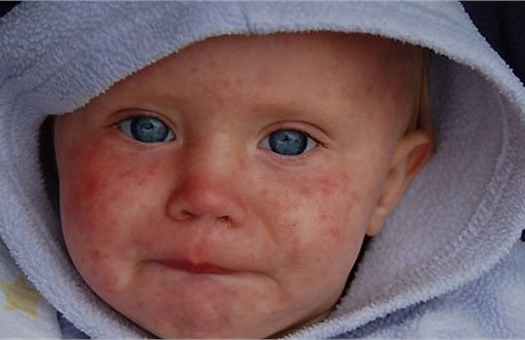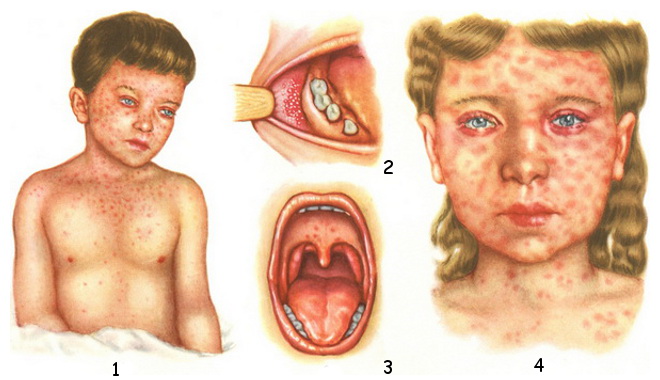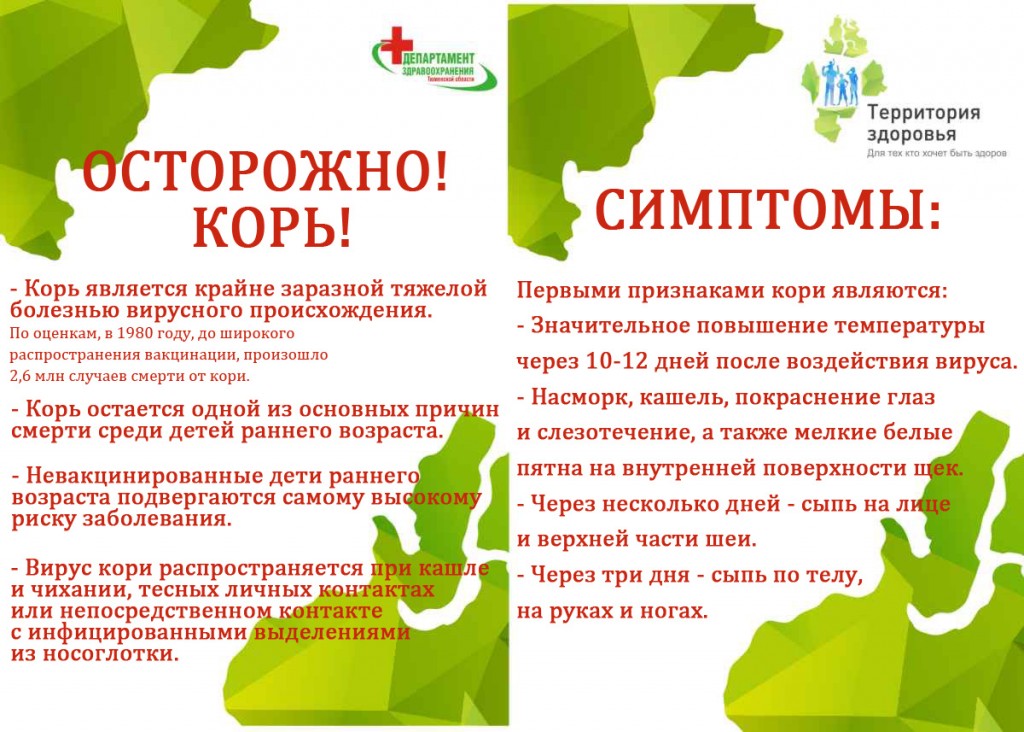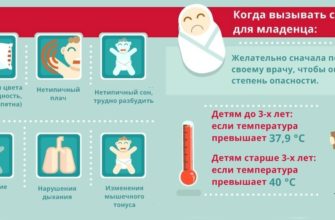Measles is an infectious disease that is transmitted by airborne droplets. A child who has not been vaccinated will get a 100% chance of contact with an infected person. Such a percentage of susceptibility is not observed in almost any other diseases.

Measles in children proceeds in an acute form, especially at the age of 2 to 5 years. The disease virus enters the body through the respiratory tract, and then spreads through the bloodstream. With this disease, mainly the mucous membranes of the eyes, the oral cavity and respiratory organs are affected, a characteristic rash, conjunctivitis appears, and the temperature rises.
Causes of Measles
The cause of the spread of infection is always a sick person. The virus enters the air through droplets of saliva released during coughing, sneezing or talking, and then "moves" into the respiratory tract of a child nearby. The patient is considered contagious during the last two days of the incubation period of the virus and up to the 4th day of the rash.
Measles in children under one year of age is extremely rare, because they still have little contact with the outside world and strangers. In addition, newborns are protected by maternal antibodies. In infants, the disease can proceed not quite usually and differ in the following signs: lack of temperature, slight runny nose, slight redness in the oral cavity.
At the same time, babies in their first year of life may experience complications that, in severity, exceed measles itself and affect primarily the respiratory and cardiovascular systems.
In ill children, the immunity to the disease persists until the end of life. If the mother was ill with measles in the past, the child will be resistant to the disease until the age of 3 months. It is this period of time that maternal antibodies are contained in the blood of the child. Also, after vaccination, immunity develops and the child will be protected from measles.
Symptoms and stages of the disease

Measles is an insidious disease that develops in stages. In the early days, the disease may not manifest itself at all, the children remain cheerful and playful. The virus spreading through the child’s body is still completely invisible to the sensitive eyes of the parents. This is the insidiousness of the very first period of the course of the disease, and there are four in all.
1. The incubation period
This is the time period that begins at the time of infection and continues until the first signs of the disease appear. It is believed that this period in children is 7-14 days.At this stage, the virus in the body multiplies “quietly”, there are no measles symptoms, the child is absolutely not worried about anything. At the same time, the baby becomes contagious to others only in the last 5 days of the incubation period.
2. Catarrhal period
During this period, the child has symptoms that are very reminiscent of a cold:
- general malaise, weakness, lack of appetite;
- increase in body temperature up to 40 ° C;
- headaches;
- dry cough;
- runny nose and hoarse voice;
- increased lacrimation, swelling and redness of the eyelids, conjunctivitis (drops and ointments for conjunctivitis);
- abdominal pain and loose stools;
- runny nose with purulent-mucous discharge from the nose;
- lacrimation, photophobia;
- in infants, a decrease in body weight may be observed.
Documentary
The catarrhal period of the disease lasts no more than four days, during which all the symptoms of measles gradually turn into more severe forms. At the moment when all manifestations reach the highest levels, a rash begins to appear.
3. The period of rashes
As already noted, the rash appears at the time of the peak state of all signs of the disease. Spots of a dark red hue appear primarily on the head. Gradually expanding and merging with each other, they form large foci of rashes. It is for this reason that the child’s face swells, and the lips become dry and often crack.
On the second day of this period, the rash begins to appear on the arms and upper body. The third day is characterized by the appearance of rashes on the whole body of the child. The duration of the entire period is 4 days.
The rash period is characterized by a decrease in body temperature, weakening cough and the appearance of appetite. The child becomes mobile and active. About a week after the onset of the rash, the catarrhal symptoms disappear completely.
4. Stage pigmentation
The rash leaves behind pigmented spots, the appearance of which occurs in the same sequence: first on the face, then throughout the body. These spots gradually begin to peel off and eventually pass completely.
At the stage of pigmentation, the condition of the child gradually returns to normal, sleep and appetite are fully restored, and body temperature does not exceed normal values.
Custom Measles
If a child has measles, you may not always be able to notice the development of this disease. Measles may not flow as usual, but in a different form. Such forms of the course of the disease are called atypical.
Mitigated form
Children who have been in contact with an infected child receive immunoglobulin for prophylaxis. For such children, the overall picture of the disease becomes blurred:
- the incubation period lasts 21 days;
- in the catarrhal period there is a slight cough and runny nose;
- all periods of the disease, except incubation, are reduced;
- rashes are not plentiful and appear without compliance with phasing;
- on the cheeks there are no characteristic spots;
- pigmentation is less dark.
Abortive measles
With this atypical form, all signs of the disease appear according to the standard scheme. But after about 2-3 days, all the symptoms of the disease disappear sharply. Rashes focus on the face and upper torso.
Worn out form
This form of measles strongly resembles mitigated. Here, the catarrhal signs of the disease are just as insignificant. However, unlike the mitigated form, the erased one is characterized by the absence of a rash. This factor greatly interferes with the correct diagnosis.

Diagnosis of the disease
It is often difficult or even impossible to recognize a disease only by external manifestations. This is especially true for atypical forms of the disease. In addition, the first signs of measles strongly resemble a cold, which can mislead anyone.
To make a reliable diagnosis, your child must be sent to the following types of laboratory tests:
- general blood analysis;
- general urine analysis;
- serology (detection of antibodies to measles virus in the blood);
- detection of measles virus in the blood.
Additionally, the child can be sent for chest x-ray, and in the presence of complications from the nervous system - for electroencephalography.
In most cases, with the standard development of the disease, the diagnosis is not difficult and laboratory tests are simply superfluous.
Treatment
[sc: rsa]
There are no special methods of treating measles, the body will cope with the infection on its own. The treatment here is symptomatic, which will alleviate the general condition of a sick child:
- antipyretic drugs at elevated body temperature;
- cough medicine, depending on its type (for wet and dry, different medications are used);
- remedies for the common cold and sore throat;
- heavy drinking and bed rest.
During the period of the disease, it is also important to provide the child with the necessary vitamin complexes to maintain immunity, and lubricate chapped lips with petroleum jelly.
Symptomatic treatment is carried out at home under the supervision of a pediatrician. A child is placed in a hospital ward if complications begin to develop. In the presence of complications, therapy is supplemented with antibacterial drugs.
Complications of the disease
Complications develop, as a rule, in children under 5 years of age or in adults “under the age of 20”. The most common ones are:
- otitis;
- laryngitis;
- stomatitis;
- encephalitis;
- inflammation of the lymph nodes in the neck;
- bronchopneumonia.
Complications arising in young children are hardly a rare occurrence. That is why it is necessary to treat the baby under the close supervision of the local pediatrician. Ideally, if the doctor visits your child at least once every three days.
Why do such consequences occur? Everything is very simple. The measles virus is able to inhibit the immunity of a small patient, and this is an excellent circumstance for the bacteria surrounding the child. They are provided with a “free entry” into the baby’s body, and they are not slow to take advantage of this. Depending on the type of bacteria that enter the child’s body, not only the above complications may occur. It is possible stool disorder, conjunctivitis and even problems from the central nervous system.
The baby's immunity decreases at the stage of rashes and may not recover earlier than after a month. Therefore, during treatment it is important to follow basic hygiene procedures, and the doctor should not stop being observed even after recovery.
Prevention
The first step in the prevention of the disease is to limit contact with sick children. A child with signs of this infection should be isolated from other (not sick) children for the entire period when he is contagious. The patient's room should be regularly ventilated, and wet cleaning is also needed.
For children in contact with the patient, a special immunoglobulin is administered in the first 5 days after contact, which helps them not to get sick. Such a measure is taken in respect of babies who have not previously been vaccinated.
It's important to know! Immunoglobulin is administered only to immunocompromised children under three years of age.
But the most reliable assistant for measles prevention is vaccination.
Video: how to protect yourself and children from measles
Graft
We have already said that the vaccine is the most effective method in the prevention of measles. Vaccination is an artificial infection of the virus. But its concentration is so small that the child’s body copes with the infection on its own and at the same time produces protective antibodies.
After vaccination, it is possible:
- slight increase in temperature;
- the appearance of conjunctivitis;
- small rash on the body.
All this is completely safe and passes in 2-3 days.
Note! The vaccine is contraindicated in children with weakened immunity and having diseases of the blood or heart. A vaccine is a living measles bacteria. It is possible to vaccinate a child only in the absence of contraindications.
The first vaccination is carried out in children at the age of one year, revaccination - at 6 years.Further, you can hope for a long-term effect that provides your child with protection against the virus for 15 years. Look vaccination calendar
Measles is not a pleasant disease. In addition, in young children, it is often complicated by other unpleasant diseases, which can do much more harm than measles itself. At the same time, babies who have had this sore once have acquired lifelong immunity.
A measles vaccine is a reliable method of preventing the disease, but it is not a panacea. Before you agree to vaccination, you must make sure that the child has strong immunity and there are no other contraindications.
We also read:









In our region there was a case of death after a vaccine for a small child, now we don’t know whether our baby should do it or not ... Maybe it’s better to get sick and that’s all, although I read a lot that it is dangerous for a fragile organism.
Measles, of course, is a serious disease, but I want to tell all the mothers the main effective treatment here, I carefully monitored the temperature, knocked it down, and after a few days of bed rest, the child started recovering. Of course, he ate little at that time, but drank a lot.
We did not get measles vaccine for the eldest daughter, since I was ill with her in childhood and believed that immunity would remain. But at the age of 5 she became ill, probably in the kindergarten she became infected. How did we suffer: our lymph nodes became inflamed and the temperature was high. And most importantly, there is no cure for measles. Therefore, the youngest was already vaccinated. It is better to prevent the disease than to suffer later.
Prevention also involves the removal of unvaccinated children from the team where the patient was, during the infectious period of the disease - the first few days after the rash. Immediately after contact, children unvaccinated against measles are quarantined for up to three weeks.